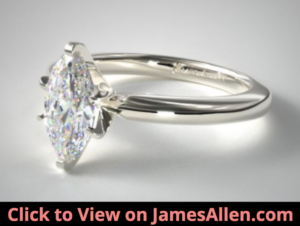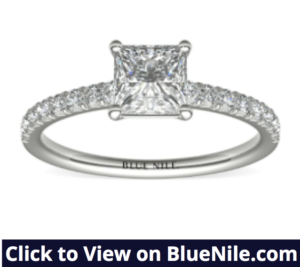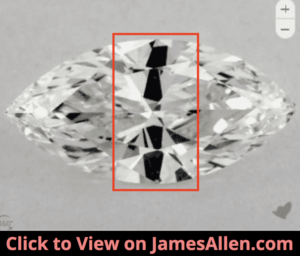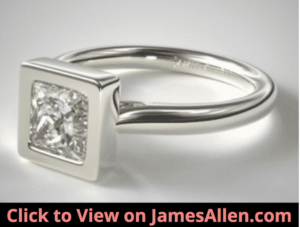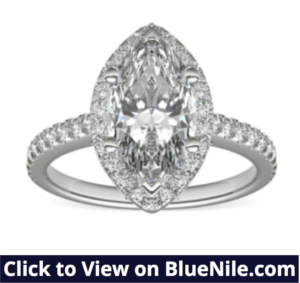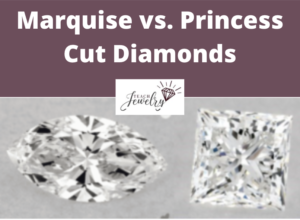
Comparing diamond cuts is about learning their unique features and how they perform as the main stone in an engagement ring or another piece of fine jewelry.
There are many to choose from, but two that buyers often consider are marquise and princess cut diamonds.
We’ll explore marquise versus princess cuts across their most important qualities such as price, cut, clarity, brilliance and more to help you decide which is right for you.
What is a Marquise Cut Diamond?
Marquise cut diamonds are distinguished by an elongated outline that mimics the shape of an eye.
Its elliptical shape includes a wide middle that narrows as it stretches to each end. At both ends is a sharp point.
Check out the marquise cut engagement ring below.
When you rotate the image on the vendor’s website, you can identify its pointed ends and wide body.
Marquise cuts often have 58 facets. Thirty-three are on the crown and 25 are on the pavilion. It’s a modified brilliant cut, which means the facets have a similar shape as round cuts.
The overall design has been altered from the standard round brilliant cut to create the new shape that still exhibits strong brilliance and fire.
When a marquise diamond is used on a piece of jewelry, it’s often the main diamond on top of the ring, but there are settings that lay a marquise diamond along the shank parallel to the band as accents.
What is a Princess Cut Diamond?
Princess cut diamonds are known for a square or rectangular shape and brilliant cut facets. It’s also called a “square modified brilliant” because its facets are similar to a round cut but modified to create the alternate shape.
If you flip a princess cut upside down, it looks like a pyramid.
When viewed from the top-down, like in the image below, it appears square.
Most have a length to width ratio between 1.00-1.05. Any ratio in this range will resemble a square to the naked eye, so if it goes above 1.05, it’ll appear rectangular.
At that ratio, it’ll lose brilliance and fire because the facets don’t collect and return the maximum amount of white and colored light.
Princess cuts have between 50 and 58 facets. Most are located on the pavilion and crown while others are laid across the diamond’s girdle.
Princess cuts are often used as the main diamond in an engagement ring but can also line the shank of a ring with another diamond cut on top.
In some instances, you’ll find a round-cut diamond in the middle with a princess cut flanking each side.
The contrasting shapes add a stunning aesthetic to the piece.
What are the Differences Between Marquise and Princess Cuts?
1. History
Marquise diamonds are named after the Marquise of Pompadour.
In the 18th century, France’s King Louis XIV reportedly had the diamond cut to resemble the shape of her lips. After the initial cut was designed, the term referred to the rank below duke.
The marquise cut became a status symbol.
It’s also called a “Navette”, which means “small ship” in French, but it has since developed other names such as a boat-shaped, eye-shaped, or football-shaped diamond. All refer to the unique design of a marquise cut diamond.
The princess cut is a modern design. It evolved from the French cut, which has its roots in the 14th century. The princess cuts seen on engagement rings today came onto the scene in the 1980s.
Betazel Ambar and Israel Itzkowitz combined the techniques used to create round brilliant cuts but instead faceted its overall shape into a square. The goal was to offer an alternative to the traditional round cut without sacrificing too much brilliance.
As a comparison, here’s an image of a princess and marquise cut side-by-side.
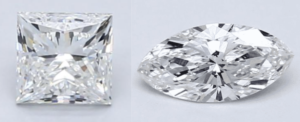
It’s easy to spot their differences, with the straight edges of the former and the rounded ones on the latter.
2. Prices
Marquise cuts often have a higher price per carat versus princess cuts, but both are less expensive than round cuts.
Fancy shapes have a lower price than round cuts because there’s less demand and more of the rough diamond is wasted when forming the round shape.
On average, expect to pay between 15-20 percent more for a marquise cut compared to a princess cut with similar qualities. For example, I compiled prices from James Allen, where I bought my wife’s engagement ring, for each diamond cut with the following qualities:
- Carat: 1.00
- Color: E
- Clarity: SI1
The average price for a marquise cut with those traits is $4,775, with a range of $4,310-$5,210.
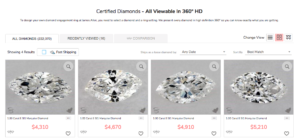
For a princess cut, the average price is $3,986, and the range is $3,400-$4,610.
That’s a 20 percent premium for a marquise diamond over a princess diamond.
At Blue Nile, the average difference is 16 percent.
There are some instances where prices for marquise and princess cuts are comparable, but in most cases, you save money by choosing a princess cut. You can put that money toward a larger carat weight, better color or clarity, or the setting.
3. Color
The color grade of a diamond refers to the presence of yellow or brown tints. Colorless diamonds with no yellow earn the highest grade, and ones with dark brown may earn a grade in the “light” category of the GIA color scale.
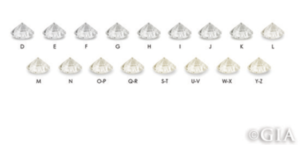
Some diamonds hide color better than others because of its proportions and light performance.
Cuts that exhibit brilliance often hide color because of the white light reflecting off the stone.
Marquise diamonds show color more easily than princess cuts, but the difference is minimal.
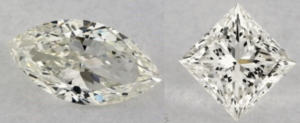
If you placed a princess and marquise cut with the same color grades next to each other, the color would likely look identical to the naked eye.
Most buyers are concerned with a diamond that appears colorless without magnification, even if it doesn’t earn the colorless distinction from the GIA.
To achieve this in a princess cut, I recommend an H or I color.
You’ll avoid the premium charged for a colorless diamond, and you won’t see it’s slight yellow tints.
For marquise cuts, I recommend an H color or higher. The shallow depth of each end will show more color than its wider middle.
To the naked eye, an H color grade on a marquise diamond will look similar to an F, E, or D grade, but it’s price will be lower.
4. Clarity
Like color, some cuts hide inclusions more than others. These clarity characteristics in a diamond take many forms such as cavities, feathers, and etch channels.
Small inclusions are often invisible to the naked eye, but avoid inclusions that impact its appearance and diminish its durability.
The brilliant cut facets of marquise and princess diamonds can make inclusions invisible without magnification. Brilliance and fire can disguise blemishes.
You don’t need to buy a flawless diamond for it to appear flawless to the naked eye.
For both princess and marquise cuts, start your search at SI1. This clarity grade offers tremendous value because the price is much lower than a flawless diamond, but they can appear identical in a normal setting.
If you’re considering a diamond higher than two carats, I recommend selecting one with at least a VS2 clarity grade.
One flaw often seen in marquise cuts is the bow-tie effect. It refers to black lines in the shape of a bow-tie that extends across its table. Here’s an image of a marquise cut with an obvious bow-tie.
Almost every marquise cut has a bow-tie, but it’s worth the effort to find one that doesn’t affect its appearance.
It’s difficult to determine if there’s a bow-tie if you only view the grading report, so always view the diamond in person or through a high-resolution photo before you buy.
5. Brilliance and Fire
Brilliance and fire are two of the most coveted characteristics in a diamond. The white and rainbow light reflecting off the diamond gives it added appeal.
If you’re comparing the brilliance and fire of princess versus marquise cut diamonds, both score high in this category because of brilliant-cut facets.
The triangle and kite-shaped facets collect light and bounce it around the diamond and out its table.
It’s also designed to minimize the amount of light that leaks from the diamond.
In a princess diamond, quality cuts exhibit both light and dark flashes. The contrast adds a unique element to the diamond as it twirls.
For a marquise cut, choosing one with an ideal length to width ratio, minimal inclusions, and quality cut will result in a brilliance and fire comparable to any other in its category except for round brilliants.
No matter which diamond you choose, the quality that most impacts its brilliance and fire is the quality of its cut.
Ensure it’s symmetrical and has very good or excellent polish. These features maximize the light performance of any diamond, including princess and marquise cuts.
6. Size
The size of a diamond is measured in carats, which is a unit of weight. If two diamonds are each three carats, they’re the same size.
But to the naked eye, one diamond can look larger than another, even if it’s the same weight.
One pro of marquise cut diamonds is they’re known to look bigger than other cuts of the same carat weight. If you placed a one-carat marquise and one-carat princess cut next to each other, the marquise cut would appear bigger.
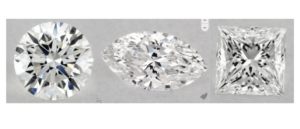
Its elongated shape results in a wide surface area compared to the squarish shape of a princess cut. The length of a marquise cut also accentuates fingers to make them look longer and slimmer.
You should consider a marquise cut if the size of your diamond is an important feature for you.
7. Popularity as Engagement Rings
Princess cuts are more popular than marquise cuts. About 30 percent of engagement ring diamonds sold are princess cuts. Marquise cuts account for about five percent.
Both fall short of round cuts, which make up over 50 percent of the market.
The princess cut was most popular in the 1980s and 1990s because it was new on the scene. The combination of an alternative shape and strong brilliance caused it to rise in popularity to the second most common cut.
Marquise cuts were most popular right before the invention of the princess cut. In the 1970s and 1980s, its elongated shape and brilliant-cut facets made it a frequent choice for engagement rings.
Because they both rank in the top five most popular diamond cuts, there are a variety available at most jewelry retailers in a range of carat weights and color and clarity grades.
8. Durability
Durability is a concern for marquise and princess cuts. The most vulnerable areas of a diamond are sharp corners, and they’re included on both cuts.
On a princess cut, there are four corners that form right angles. If they’re hit against a hard surface or dropped, they may chip.
It’s important to place them in a setting that protects each corner, such as V-prongs or a bezel setting.
The example below is a bezel setting.
Marquise cuts have the same issue. Its wide middle extends to two sharp points, which are susceptible to breaking.
Some settings that improve its durability have a simple design. It features V-prongs at each end and standard prongs holding the middle.
Others have three prongs on each end with several more grasping the middle.
Explore the variety of settings available that hold princess and marquise cut to learn which one finds the right balance between enhancing its durability while also not blocking light from entering the diamond.
9. Settings
Don’t ignore the impact of choosing the right setting for your marquise or princess cut.
Both fit a variety of styles, but there are certain ones that complement its shape.
To begin with, both can stand alone as a solitaire because of their light performance. You’ll often find a halo or pave on a step-cut to compensate for its warm glow.
For example, check out this princess cut in a 14K yellow gold solitaire setting.
It’s a stunning piece that’s perfect for a proposal.
But if you’re interested in additional stones on the ring, here’s an example of marquise cut with those features.
Notice how the halo mimics the shape of the cut. From a distance, they can blend together and make the main diamond appear larger.
Whether you land on a channel-set, pave, a three-stone ring, or a vintage setting, both cuts can pair with any of those designs.
Is a Marquise or Princess Diamond Right For You?
Comparing a marquise versus princess cut diamond involves understanding the qualities that impact their appearance and light performance.
Both brilliant cuts offer a unique diamond compared to the traditional round cut but have differences in their price, size, popularity and more.
Here are some guidelines to help you decide between a marquise and princess cut.
Choose a marquise cut if:
- You’re looking for a diamond that looks larger than all other cuts
- You’re willing to choose a setting that prevents its ends from chipping
- You want a diamond that isn’t as popular as some other brilliant cuts
- The elongated shape is appealing to you, and you want a ring that makes your fingers look more slim
Consider a princess cut if:
- You want a diamond with a square or rectangular shape with strong brilliance
- You’re interested in a fancy shape but still want a popular cut
- You’re looking for a lower price-per-carat than a marquise cut
Examine all the options at online and in-person retailers, and pair them with different settings.
By knowing how each cut is unique and which settings are the best fit, you can find the right princess or marquise diamond for you.

Jacob Clarke
Jacob Clarke is the founder of TeachJewelry.com.
He earned an Applied Jewelry Professional Diploma from the Gemological Institute of America (GIA) and now brings you essential information about diamonds, settings, and more.
Jacob has consulted with leading jewelry brands, and his work has been cited in Clean Origin, Diamond Nexus and industry publications.
He's also a member of the International Gem Society.
He enjoys discussing jewelry with readers, so contact him with any questions at jacob.clarke@teachjewelry.com.

